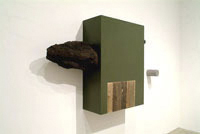Review: Daniel Roth at Donald Young Gallery |
By Ed Schad
|
 In Daniel
Roth�s current project on view at Donald Young Gallery, the story of the Cabrini
Green Forest comes into being through multiple forms of documentation. According
to Roth, a mythical forest exists in a tunnel that connects the Metropolitan
Correctional Facility in downtown Chicago to the Cabrini Green Housing projects.
In this exhibition, a literal architectural schema, a literary technique made
famous by Franz Kafka, becomes a metaphor for the dark undercurrents of societal
relations. Roth presents his fantastic story in a rather straightforward manner.
As the modern precision of the correctional facility is reduced to crumbling
bricks by the toils of age, an opening in the basement reveals a well kept secret,
a system of criminal exchange planned long ago and carried into the present�a
tunnel.
In Daniel
Roth�s current project on view at Donald Young Gallery, the story of the Cabrini
Green Forest comes into being through multiple forms of documentation. According
to Roth, a mythical forest exists in a tunnel that connects the Metropolitan
Correctional Facility in downtown Chicago to the Cabrini Green Housing projects.
In this exhibition, a literal architectural schema, a literary technique made
famous by Franz Kafka, becomes a metaphor for the dark undercurrents of societal
relations. Roth presents his fantastic story in a rather straightforward manner.
As the modern precision of the correctional facility is reduced to crumbling
bricks by the toils of age, an opening in the basement reveals a well kept secret,
a system of criminal exchange planned long ago and carried into the present�a
tunnel.
Nothing creates more intrigue than the eerie spaces of underground tunnels.
Take the debate over whether or not mole people make their home in the abandoned
subway tunnels of New York. However, speculation must eventually give way to
proof, and in the case of the Cabrini Green Forest, Roth is there to provide
such proof, at least in the ways proof is typically presented. Roth documents
the tunnel and the forest. He has an architectural blueprint of the tunnel.
He has a photograph of a mining car that possibly served as a vehicle for the
tunnel. He offers elaborate drawings of the forest. Finally, Roth provides two
concrete documentation elements: an opening to the tunnel and an electrical
box that has over time been invaded by the roots of a tree growing in its proximity.
Roth presumably took these last two items directly from the depths underneath
Chicago.
In the context of a gallery, Roth�s evidence does not add up; seemingly, the
gallery walls themselves prohibit the possibility that this tunnel could indeed
exist. Art, of course, is just the mirror of life. However, if one were to imagine
the same items tagged and bagged in a courtroom, a jury perhaps would be convinced.
Which leads the viewer to consider how myths are constructed, and whether or
not any of these myths could possibly have grounds in the real world?
The exhibition presents a variety of myths focused on the controversies surrounding
urban life: the implied connection between abject poverty and criminal behavior,
an implicit cynicism over the effectiveness of rehabilitation, and the questioning
of the dynamic between law and crime. Rather boldly, Roth actually takes a stand
on these urban questions and the installation seems to give a series of answers.
His initial move in the exhibition is the sculpture of a dark opening, a door
into the tunnel set on the floor as it does in the blueprint of the Metropolitan�s
basement. The square portal recalls the washing pool of a Roman atrium, a place
for purification before entering the domestic house, a place where proper society
interacts. However, Roth�s cleansing pool is green and the water inside is brackish
and turbid suggesting that the purification of society is just another myth
constructed for our benefit.
The tunnel is surprisingly ambiguous. Whether the passage was used for escape
or internment is unknown; the installation presents only one certainty, the
sinuous existence of tree roots, which take over and fortify the tunnel against
any future use. This suggests that the relationship between the Cabrini Green
Projects and the Metropolitan Correctional facility is a strained one, and even
the trees rise in revolt against such a connection.
Visit the Donald Young Gallery at www.donaldyoung.com/.
 In Daniel
Roth�s current project on view at Donald Young Gallery, the story of the Cabrini
Green Forest comes into being through multiple forms of documentation. According
to Roth, a mythical forest exists in a tunnel that connects the Metropolitan
Correctional Facility in downtown Chicago to the Cabrini Green Housing projects.
In this exhibition, a literal architectural schema, a literary technique made
famous by Franz Kafka, becomes a metaphor for the dark undercurrents of societal
relations. Roth presents his fantastic story in a rather straightforward manner.
As the modern precision of the correctional facility is reduced to crumbling
bricks by the toils of age, an opening in the basement reveals a well kept secret,
a system of criminal exchange planned long ago and carried into the present�a
tunnel.
In Daniel
Roth�s current project on view at Donald Young Gallery, the story of the Cabrini
Green Forest comes into being through multiple forms of documentation. According
to Roth, a mythical forest exists in a tunnel that connects the Metropolitan
Correctional Facility in downtown Chicago to the Cabrini Green Housing projects.
In this exhibition, a literal architectural schema, a literary technique made
famous by Franz Kafka, becomes a metaphor for the dark undercurrents of societal
relations. Roth presents his fantastic story in a rather straightforward manner.
As the modern precision of the correctional facility is reduced to crumbling
bricks by the toils of age, an opening in the basement reveals a well kept secret,
a system of criminal exchange planned long ago and carried into the present�a
tunnel.